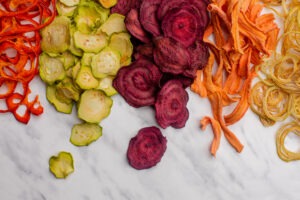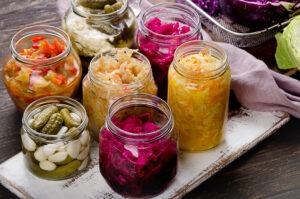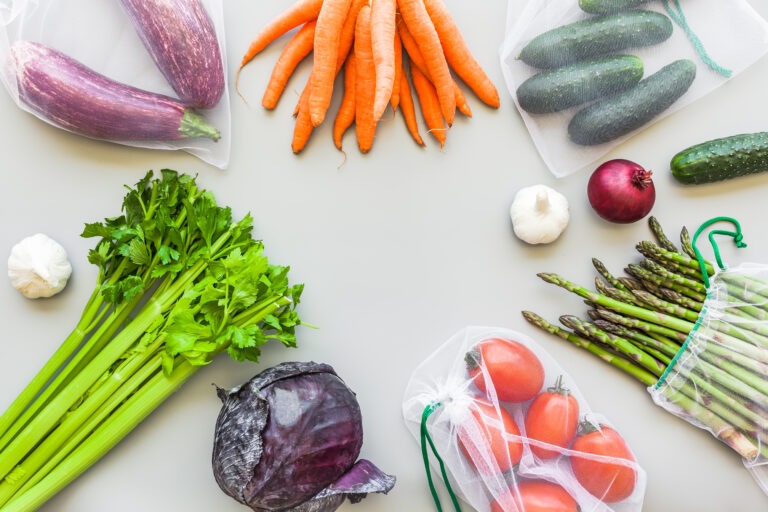Summer is a time of bounty for fresh fruits and vegetables. Whether your garden is flourishing with more than you can eat, or you’ve purchased an abundance at your local market, you may need some help with how to preserve what you can’t eat fresh. Luckily, there are a variety of options to choose from when considering increasing the shelf life of your produce!
STORE FOOD FOR MAXIMUM FRESHNESS
The simplest thing you can do to preserve your harvest is to store each type of produce the right way. Download SWACO’s Food Storage Guide for a quick reference on how to store (and freeze or revive!) common veggies and fruits as well as dairy, eggs and bread. Save the Food’s Interactive Storage Guide is another great tool that includes a more comprehensive list of foods including beans, oils, meats and seafood.
DEHYDRATION
 When considering longer-term food preservation, there are several methods you can try. One of the easier preservation techniques is dehydration. This technique preserves produce by removing moisture and therefore creating an environment where spoilage bacteria can’t exist. Electric dehydrators are a very effective tool for dehydrating produce. The Purposeful Pantry offers some guidance for considering what type of dehydrator might fit your needs.
When considering longer-term food preservation, there are several methods you can try. One of the easier preservation techniques is dehydration. This technique preserves produce by removing moisture and therefore creating an environment where spoilage bacteria can’t exist. Electric dehydrators are a very effective tool for dehydrating produce. The Purposeful Pantry offers some guidance for considering what type of dehydrator might fit your needs.
However, instead of buying a new tool for your kitchen, there are several alternative and budget-friendly ways to dehydrate as well. Although not recommended for vegetables, sun-drying is a very easy approach for dehydrating fruit. Requiring minimal effort, sun-drying will reward you with tasty snacks like dried apples and mangos, or salad toppers like tomatoes. Read about how to make sun-dried strawberries.
Alternatively, you can opt to dehydrate in the oven, which works for a variety of fruits and vegetables. This process entails setting your oven around 140°F (or lower, if your oven has the option) and allowing produce to expel moisture over the course of several hours. Try making oven-dried carrots using this recipe.
FERMENTATION

Fermentation requires more attention to process and proportions and a willingness to troubleshoot if something goes wrong. The fermentation process is the transformative action of microorganisms. Bacteria, yeasts, and other microorganisms are the agents that change substances in anaerobic (without oxygen) and aerobic (with oxygen) environments to produce a broad list of foods including cheese, yogurt, sauerkraut, pickles, kombucha, beer, wine, cider, vinegar, soy sauce and many others. Fermented foods store well for extended periods of time without refrigeration and boast numerous health benefits. Many fermented foods are packed with probiotics resulting from the lactic acid bacteria that help create these ferments and diversify your gut flora, increasing the absorption of nutrients. Since fermenting requires the maintenance of a specific environment that supports the growth of healthy bacteria, and suppression of unwanted microorganisms, attempting this process can feel daunting at first. Sauerkraut is a great fermented food for beginners to try out, and this Sauerkraut video tutorial is as informative as it is entertaining. For those interested in understanding fermentation, Sandor Katz’s The Art of Fermentation is an essential resource on fermentation. Access a free online version of the text via the Internet Archive.
CANNING

Yet another option for preserving your harvest is canning. Canning involves submerging produce (or other foods) in jars of salty or syrupy water and removing all the air out of the jars before sealing them. Canned goods last years on the shelf, and this method is an excellent option for preserving raw and processed fruits and vegetables as well as meats, soups, jams and jellies. There are two methods of canning: water bath canning and pressure canning. The water bath method is a good option for canning acidic foods (like tomato sauce and fruit jams) while alkaline foods (like artichokes and corn) are better suited for pressure canning. USDA’s Complete Guide to Home Canning is a great comprehensive resource for anyone looking to try canning. Canners should take food safety precautions to heart because improperly home-canned foods can cause serious illness and death from botulism. Taking a class can build confidence in proper safety practices so consider a local or virtual course, listed below.
FIND A LOCAL OR VIRTUAL CLASS
You may already feel confident in trying one or all these methods of preservation, but if not, there are a variety of local organizations that offer classes and information about food preservation.
In-person Classes
-
- Class topic(s): canning, dehydrating, and freezing
- Where: Lancaster, OH and/or Pickerington, OH
- Other details: free, multiple dates throughout summer
-
- Class topic(s): canning, dehydrating, and fermenting
- Where: Sunbury, OH
- Other details: private group classes
-
- Class topic(s): canning
- Where: Lebanon, OH
- OEFFA and Columbus Garden School sometimes offer classes on these subjects. Check for future courses!
Recordings/Webinars
- OSU’s Extension Food Preservation webinar recordings (free upcoming webinars)
-
- Video topic(s): canning, limited fermentation and dehydrating
- OSU Extension (free recordings)
-
- Video topic(s): canning, dehydrating, and fermenting
This is a snapshot list of resources and recipes, but we hope it helps to enrich or jump-start your food preservation journey!

